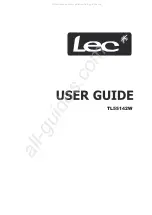
15
loss of consciousness. Higher exposures to the va-
pors may cause temporary alteration of the heart’s
electrical activity with irregular pulse, palpitations,
or inadequate circulation. Death can occur from
gross overexposure. Intentional misuse or deliber-
ate inhalation of Suva
®
HP refrigerant vapors may
cause death without warning. This practice is ex-
tremely dangerous.
A person experiencing any of the initial symptoms
should be moved to fresh air and kept calm. If
breathing is difficult, administer oxygen. If not
breathing, administer artificial respiration. Call
a physician.
Cardiac Sensitization
As with many other halocarbons and hydrocarbons,
inhalation of Suva
®
HP refrigerants followed by
intravenous injection of epinephrine, to simulate
human stress reactions, results in a cardiac sensiti-
zation response. In humans, this can lead to cardiac
irregularities and even cardiac arrest. The likeli-
hood of these cardiac problems increases if you are
under physical or emotional stress. The Suva
®
HP
refrigerants can cause these responses well above
the AEL, but the effect level varies with people,
and has not been fully determined.
If you are exposed to very high concentrations of
Suva
®
HP refrigerants, move immediately from the
area, and seek medical attention as a precaution.
Do not
attempt to remain in the area to fix a leak or
perform other duties—the effects of overexposure
can be very sudden.
Medical attention must be given immediately if
someone is having symptoms of overexposure to
Suva
®
HP refrigerants.
Do not
treat the patient with
drugs such as epinephrine. These drugs could in-
crease the risk of cardiac problems. If the person is
having trouble breathing, administer oxygen. If
breathing has stopped, administer artificial respira-
tion. Call a physician.
Skin and Eye Contact
At room temperature, Suva
®
HP refrigerant vapors
have little or no effect on the skin or eyes. How-
ever, in liquid form, they can freeze skin or eyes
on contact, causing frostbite. If contact with liquid
does occur, soak the exposed areas in lukewarm
water, not cold or hot. In all cases, seek medical
attention immediately.
Always wear protective clothing when there is
a risk of exposure to liquid refrigerants. Where
splashing of refrigerant may occur, always wear
eye protection and a face shield.
Spills or Leaks
If a large release of vapor occurs, such as from
a large spill or leak, the vapors may concentrate
near the floor or in low elevation areas, which can
displace the oxygen needed for life, resulting in
suffocation.
Evacuate everyone until the area has been well
ventilated. Re-enter the area only while using
self-contained breathing apparatus. Use blowers
or fans to circulate the air at floor or low levels.
Always use self-contained breathing apparatus or
an air-line respirator when entering tanks or other
areas where vapors might exist. Use the buddy sys-
tem (a second employee stationed outside the tank)
and a lifeline. Refer to the Material Safety Data
Sheet for the specific Suva
®
HP refrigerant you
plan to use.
Suva
®
HP refrigerants have virtually no odor, and
therefore can be extremely difficult to detect in
enclosed areas. Frequent leak checks and the instal-
lation of permanent leak detectors may be neces-
sary for enclosed areas or machinery rooms. Refer
to ASHRAE Standards 15 and 34 for machinery
room requirements.
To ensure safety when using Suva
®
HP refrigerants
in enclosed areas:
1. Route relief and purge vent piping outdoors,
away from air intakes.
2. Make certain the area is well ventilated at all
times; use auxiliary ventilation, if necessary, to
remove vapors.
3. Make sure the work area is free of vapors prior
to beginning any work.
4. Install air monitoring equipment to detect leaks.
Combustibility of Suva
®
HP
Refrigerants
Suva
®
404A (HP62), HP80 and HP81 are not flam-
mable in air at temperatures up to 100°C (212°F) at
atmospheric pressure. However, mixtures of HP62,
HP80 or HP81 with high concentrations of air at
elevated pressure and/or temperature can become
combustible in the presence of an ignition source.
Suva
®
404A (HP62), HP80 and HP81 can also be-
come combustible in an oxygen enriched environ-
ment (oxygen concentrations greater than that in
air). Whether a mixture containing Suva
®
404A
(HP62), HP80 or HP81 and air, or Suva
®
404A
(HP62), HP80 or HP81 in an oxygen enriched
atmosphere becomes combustible depends on the
inter-relationship of 1) the temperature 2) the
pressure, and 3) the proportion of oxygen in the








































